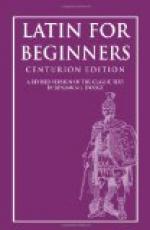Va:’de ad formi:’cam, O: pi’ger, et co:nsi:’dera: vi’a:s e’ius et di’sce sapie’ntiam: quae cum no:n ha’beat du’cem nec praecepto:’rem nec pri:’ncipem, pa’rat in aesta:’te ci’bum si’bi et co’ngregat in me’sse quod co’medat.
[[Go to the ant, thou sluggard; consider her ways, and be wise: which, having no guide, overseer, or ruler, provideth her meat in the summer and gathereth her food in the harvest.]]
QUANTITY
11. The quantity of a vowel or a syllable is the time it takes to pronounce it. Correct pronunciation and accent depend upon the proper observance of quantity.
12. Quantity of Vowels. Vowels are either long (^) or short. In this book the long vowels are marked. Unmarked vowels are to be considered short.
[Transcriber’s Note: The wording of Sec. 12 is as in the original, except that the macron (long-vowel symbol) has been replaced with a caret ("hat"), and the breve (short-vowel symbol) has been omitted.]
1. A vowel is short before another
vowel or h; as po-e:’-ta\,
tra’-ho:\.
2. A vowel is short before nt and nd, before final m or t, and, except in words of one syllable, before final l or r. Thus a’-mant\, a-man’-dus\, a-ma:’-bam\, a-ma:’-bat\, a’-ni-mal\, a’-mor\.
3. A vowel is long before nf,
ns, nx, and nct. Thus
i:n’-fe-ro:\, re’-ge:ns\,
sa:n’-xi:\, sa:nc’-tus\.
4. Diphthongs are always long, and are not marked.
13. Quantity of Syllables. Syllables are either long or short, and their quantity must be carefully distinguished from that of vowels.
1. A syllable is short,
a. If it ends in a short vowel; as a’-mo:\, pi’-gri\.
NOTE. In final syllables the short vowel may be followed by a final consonant. Thus the word me-mo’-ri-am\ contains four short syllables. In the first three a short vowel ends the syllable, in the last the short vowel is followed by a final consonant.
2. A syllable is long,
a. If it contains a
long vowel or a diphthong, as cu:’-ro:\,
poe’-nae\, aes-ta:’-te\.
b. If it ends in a
consonant which is followed by another
consonant, as cor’-pus\,
mag’-nus\.
NOTE. The vowel in a long syllable may be either long or short, and should be pronounced accordingly. Thus in ter’-ra\, in’-ter\, the first syllable is long, but the vowel in each case is short and should be given the short sound. In words like saxum\ the first syllable is long because _x_ has the value of two consonants (_cs_ or _gs_).
3. In determining quantity h is not counted a consonant.




